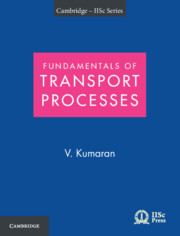Book contents
- Frontmatter
- Dedication
- Contents
- Preface
- 1 Introduction and Dimensional Analysis
- 2 Dimensionless Groups and Correlations
- 3 Diffusion and Dispersion
- 4 Unidirectional Transport: Cartesian Co-ordinates
- 5 Unidirectional Transport: Curvilinear Co-ordinates
- 6 Pressure-driven Flow
- 7 Conservation Equations
- 8 Diffusion Equation
- 9 Forced Convection
- 10 Natural Convection
- Bibliography
- Index
10 - Natural Convection
Published online by Cambridge University Press: 28 February 2025
- Frontmatter
- Dedication
- Contents
- Preface
- 1 Introduction and Dimensional Analysis
- 2 Dimensionless Groups and Correlations
- 3 Diffusion and Dispersion
- 4 Unidirectional Transport: Cartesian Co-ordinates
- 5 Unidirectional Transport: Curvilinear Co-ordinates
- 6 Pressure-driven Flow
- 7 Conservation Equations
- 8 Diffusion Equation
- 9 Forced Convection
- 10 Natural Convection
- Bibliography
- Index
Summary
In the analysis of transport at high Peclet number in Chapter 9, it was assumed that the fluid velocity field is specified, and is not affected by the concentration or temperature variations. There are situations, especially in the case of heat transfer, where variations in temperature cause small variations in density, which results in flow in a gravitational field due to buoyancy. Examples of these flows range from circulation in the atmosphere to cooking by heating over a flame. In the former, air heated by the earth's surface rises and cold air higher up in the atmosphere descends due to buoyancy; in the latter, hotter and lighter fluid at the bottom rises due to buoyancy and is replaced by colder and heavier fluid at the top, resulting in significantly enhanced heat transfer.
The heat transfer due to natural convection from heated objects is considered here, and correlations are derived for the Nusselt number as a function of the Prandtl number and the Grashof number. The Prandtl number is the ratio of momentum and thermal diffusion. The Grashof number, defined in Section 2.4 (Chapter 2), is the square of the Reynolds number based on the characteristic fluid velocity generated by buoyancy. In order to determine the heat transfer rate, it is necessary to solve the coupled momentum and energy equations, the former for the velocity field due to temperature variations and the latter for the temperature field. The equations are too complex to solve analytically, and attention is restricted to scaling the equations to determine the relative magnitudes of convection, diffusion and buoyancy. We examine how the dimensionless groups emerge when the momentum and energy equations are scaled, and how these lead to correlations for the Nusselt number. The numerical coefficients in these correlations are not calculated here.
Boussinesq Equations
Consider a heated object with surface temperature T0, in a ambient fluid with temperature T∞ far from the object, as shown in Fig. 10.1 The fluid density is ρ∞ far from the object, but the temperature variation causes a variation in the density near the object. This density variation results in a buoyancy force, which drives the flow.
- Type
- Chapter
- Information
- Fundamentals of Transport Processes with Applications , pp. 471 - 490Publisher: Cambridge University PressPrint publication year: 2023

